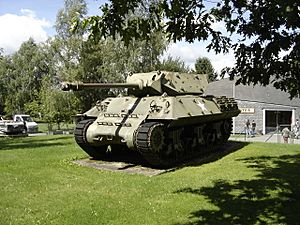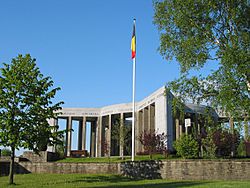Battle of the Bulge Monument facts for kids
The Battle of the Bulge Monument, also known as the Mardasson Memorial, is a special place that honors American soldiers. These soldiers were hurt or died during the World War II battle called the Battle of the Bulge. The monument is shaped like a five-pointed American star. You can find it near Bastogne in Belgium.
The idea for the memorial started on July 4, 1946. Some earth from the battle site was given to U.S. President Harry Truman. The monument was officially opened on July 16, 1950.
Contents
Monument Design
A Belgian architect named Georges Dedoyard designed this monument. It stands about 12 meters (39 feet) tall. It's shaped like a five-pointed American star, with each side being 31 meters (102 feet) long. In the middle, there's a large open area called an atrium, which is 20 meters (66 feet) wide.
Inside the monument, there are ten stone carvings. These carvings tell the story of the battle. Around the top edge, you can see the names of the 48 U.S. States that existed at the time. The walls also show symbols of many army groups that fought in the battle. These symbols represent the 76,890 soldiers who were killed or wounded. This happened during the German attack in December 1944 and January 1945. This attack was known as "Watch on the Rhine" by the Germans, but we call it the "Battle of the Bulge."
-
The names of the then 48 U.S. States are carved around the top of the Memorial. They honor American soldiers who were hurt or died in the Battle of the Bulge.
-
You can see the beautiful countryside around Bastogne from the top of the Memorial.
Below the monument, there is a special underground room called a crypt. It has three altars for different religious services: Protestant, Catholic, and Jewish. A French artist named Fernand Léger decorated this crypt with colorful mosaics.
Memorial Stone Message
There's a special stone at the memorial with words written in Latin. These words are:
- LIBERATORIBVS
- AMERICANIS
- POPVLVS BELGICVS
- MEMOR
- IV.VII.MCMXLVI.
This message means: "The Belgian people remember their American liberators – July 4, 1946."
The Story of the Battle
The ten carved panels inside the memorial tell the story of the Battle of the Bulge. Here’s what they say:
Friendship and Sacrifice
1. This memorial and the land around it are dedicated to the strong friendship between Belgium and the United States. Both countries fought together to defeat a common enemy. For the American armies, this was one of their greatest battles. Many soldiers fought bravely, and their leaders made bold decisions. For the people of Belgium, this was the last stand against an enemy. This enemy had been on their land for almost five years.
2. The enemy had tried to crush Belgium’s national spirit. This battle was the final act of a great liberation. American soldiers fought for this land as if it were their own home. Belgian civilians, even without weapons, refused to leave their homes. They faced the approaching enemy.
The German Attack Begins
The Battle of the Bulge started on December 16, 1944. The German army attacked and broke through the American front lines. They spread into the Ardennes region. At its furthest points, the attack almost reached the Meuse River. The battle ended in the last week of January 1945. The main goal for the German army was to reach the port of Antwerp.
3. The battle began in fog and darkness. The American defense line was thin. It was overwhelmed and broken by heavy gunfire and tanks. The path through the Ardennes was open. German forces advanced towards St. Vith and Bastogne. They crossed the Our River. At that time, the American forces had only two divisions as backup. These divisions were short on soldiers and equipment. In the north, near Monschau, there is a ridge called Elsenborn. This ridge is like a natural fortress.
4. Elsenborn guarded the road to Liege and the distant port. Just as the enemy launched their quick attack, an American army group was attacking this same ground. When the enemy’s guns and tanks hit these American divisions, their right side pulled back. But they held strong on the heights of Elsenborn. On the hills near Monschau, American guns fired in time with this movement. Their fire stopped the enemy army on the right. These combined efforts at the start prevented the enemy from expanding their attack towards the big cities and the sea.
Holding the Line
5. From the north, American tanks moved towards St. Vith. First, a small combat team arrived, then a whole division. From the south, a group of soldiers went to Bastogne. This group included an airborne division and a tank team. They were supposed to meet up with a tank destroyer battalion sent from the north. Right under enemy fire, all sorts of people joined the fight. Repairmen, clerks, police, and truck drivers picked up weapons. They moved to threatened crossroads, blew up bridges, or guarded important supplies. In Britain, newly arrived army groups...
6. ...were told to fly to defend the Meuse River line. The supply base in France quickly reorganized to support the battle. Their convoys, which were going elsewhere, were stopped and turned around. At St. Vith, the enemy was already swarming over the land. But the American tanks arrived in time to block the road. They blunted the attack and weakened the enemy during those critical hours. The main German tank army in the north moved around this defense. It went past Stavelot. Then, in the narrow valleys beyond the Ambleve River, it was trapped and held by the...
7. ...new forces of the counterattack. The fighting was within 20 miles of Liege. The race to Bastogne was won by the American column. They arrived just in time. The fighting started before the defenders could even get into position. They organized themselves while under fire from enemy guns. This is how the siege, now famous in history, began. The lines around Bastogne held firm, even though the battle raged all around them. The enemy’s armored army tried to take the city with direct attacks. But their men and tanks were pushed back at every point. So, the defeated tanks flowed around Bastogne...
8. ...still trying to reach the Meuse River line. Their leading edge almost reached Dinant before it was stopped by fire from the new American line. The stand at Bastogne made sure that this southern German tank army was defeated. To the south of the "Bulge," an American army had been attacking eastward. It was now told to stop and turn north. Its closest army group moved out on this mission. From this group, one division attacked towards Bastogne. The weather finally turned cold. The losses from...
9. ...exposure to the cold grew as large as the losses from fighting. The enemy attacked in snowsuits, making them hard to see. Bastogne became the main prize in the daily struggle. Men fought for shelter and warmth. The people of the Ardennes opened their homes and hearts to the defenders. They shared their food, blankets, and fuel. They even tore up their bedsheets to help hide soldiers and weapons. They cared for the wounded and helped comfort the sick. By Christmas Eve, the enemy knew their plan had failed. But there was no sudden retreat. Every hill...
10. ...and road had to be won back by strong firepower. This came at a great cost in the lives of brave men. In the battle fought here, 76,890 Americans were killed, wounded, or went missing. Rarely has so much American blood been spilled in one battle. The number of Belgians who died, were wounded, or suffered greatly while helping their friends from overseas cannot be known. For those who died and all who fought here, we who are living now can show the greatness of their actions. We do this by being even more dedicated to the freedom for which they bravely faced the fire.
Bastogne War Museum

Just a short walk from the memorial is the Bastogne War Museum. This museum shows items from World War II. It also plays a film with real footage taken during the battle.
See also
- Henri-Chapelle American Cemetery and Memorial
- Ardennes American Cemetery and Memorial






